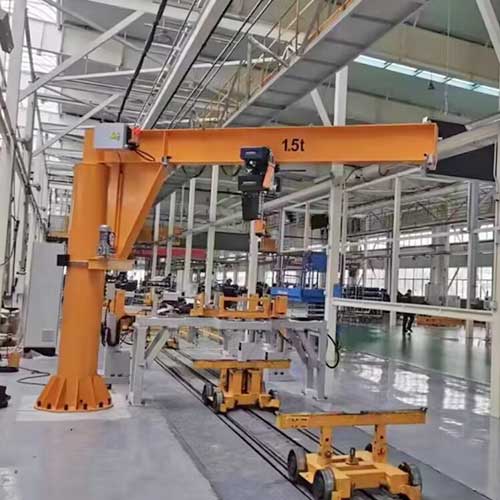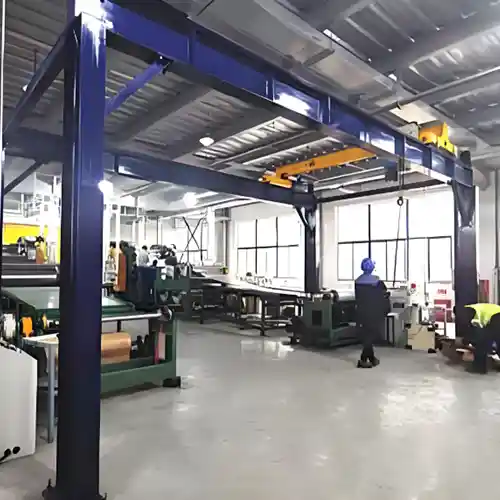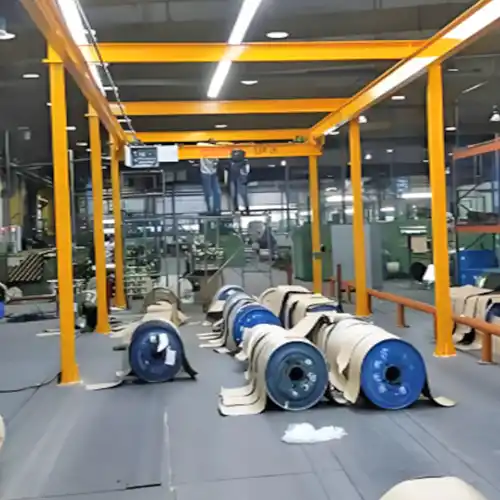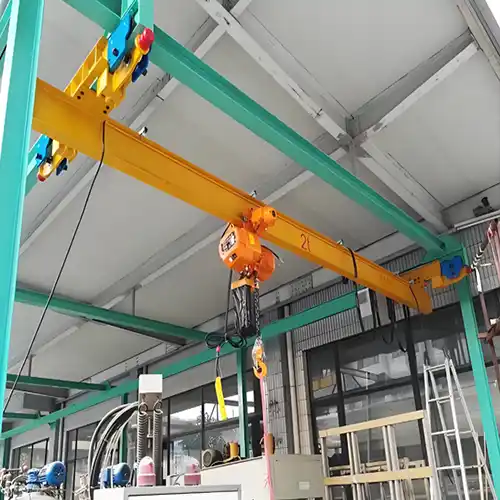Free Standing Jib Crane, 5 Ton, 10 Ton Free Standing Jib Hoist Cranes
Freestanding jib crane for sale 500kg, 1 ton, 2 ton, 3 ton, 5 ton, 10 ton, 16 ton, cost-effective floor mounted free standing crane for selection good price.
| Crane type | Free standing jib crane |
| Crane specifications | 0.5 ton -16 ton |
| Lifting Height | Customized as your request |
| Lifting span | As customer requirement |
| Note | Customized free standing jib crane are available. |
Category: Freestanding Bridge Crane
Your Trusted Free Standing Crane Manufacturer & Supplier
Free Standing Jib Crane, Types of Free Standing Jib Hoist Cranes
Freestanding jib crane for sale 500kg, 1 ton, 2 ton, 3 ton, 5 ton, 10 ton, 16 ton, cost-effective floor mounted free standing crane for selection good price.
Free Standing Jib Crane
Free standing jib cranes are a type of material handling crane that consists of a vertical mast or column that is mounted on a solid, freestanding base. At the top of the vertical mast, there is a horizontal jib or boom that extends outwards. The jib typically has a hoist or lifting mechanism attached to it, allowing for the lifting and movement of loads within a specific radius.
Key characteristics of free standing jib cranes include:
- 1. Freestanding: These cranes do not require support from building structures and are self-supporting with their own base.
- 2. 360-Degree Rotation: Free standing jib cranes often have the ability to rotate a full 360 degrees, providing a wide range of coverage within the workspace.
- 3. Lifting Capacity: The lifting capacity of a free standing jib crane can vary, with some models capable of handling light loads, while others are designed for heavier industrial applications.
- 4. Versatility: They are versatile and can be used for various material handling tasks, including loading and unloading, assembly, and positioning of materials or equipment.
- 5. Fixed or Adjustable Height: Some free standing jib cranes have an adjustable height feature, allowing for flexibility in lifting heights.
Free standing jib cranes are commonly used in workshops, manufacturing facilities, warehouses, and other industrial settings where the need for efficient and controlled material handling exists. They are especially useful in areas where overhead crane systems may not be practical or feasible due to space limitations.
Main types of free standing jib cranes
Based on Jib Structure Design:
- Fixed Jib Crane: These cranes have a stationary jib arm with no ability to move or rotate. They are ideal for applications where loads are consistently located in one specific area, and precise positioning is not required.
- Articulating Jib Crane (Knuckle Boom Crane): Articulating jib cranes have a two-part jib arm that can articulate or bend at an elbow joint. This design offers precise load positioning in tight spaces and complex layouts.
- Telescoping Jib Crane: These cranes have an extendable or telescoping jib arm, allowing for variable reach. They are suitable for applications where loads may need to be positioned at varying distances from the crane's support column.
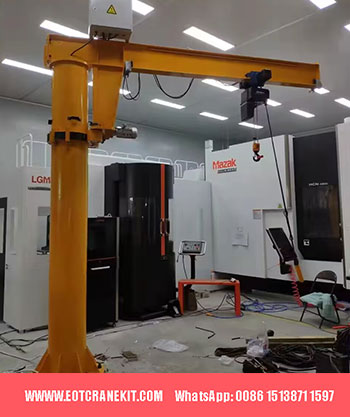
Floor mounted fixed Jib Crane 5 Ton 10 Ton :
Structure: Fixed jib cranes have a stationary jib arm that extends horizontally from the support column. The jib arm does not have any articulation points, making it rigid and immovable.
Movement: Fixed jib cranes do not have movement features, as their jib arm remains fixed in place.
Features:
- Stability and simplicity in design.
- Lower maintenance requirements due to fewer moving parts.
- Cost-effective solution for stationary material handling needs.
Benefits:
- Provides a stable and secure point for lifting and positioning loads within a limited range.
- Suitable for applications where loads are consistently located in one specific area.
- Minimal maintenance and upkeep required.
Applications/Use Cases:
- Loading and unloading materials in a specific work area.
- Assembling or positioning items on a fixed production line.
- Handling materials within a confined workspace where precision is not essential.
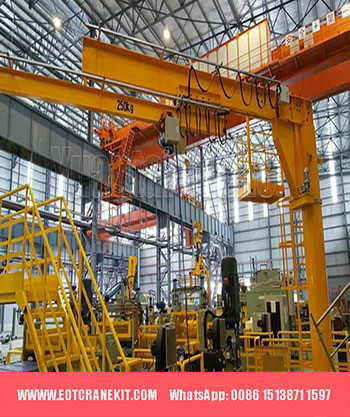
Telescoping Jib Crane 500kg -2 Ton :
- - Structure: Telescoping jib cranes have a jib arm that can extend or retract using multiple sections that slide into one another. This design allows for adjustable reach.
- - Movement: Telescoping jib cranes primarily offer horizontal extension and retraction of the jib arm to vary the reach.
Features:
- Adjustable reach for versatile material handling.
- Typically designed with multiple telescoping sections.
- Can be equipped with various hoisting mechanisms.
Benefits:
- Adaptability to handle loads at varying distances from the crane's support column.
- Versatile and suitable for applications with changing requirements.
- Maximizes workspace utilization by reaching different areas.
Applications/Use Cases:
- Handling materials on a production line with varying workstations.
- Loading and unloading trucks or containers of different sizes.
- Reaching over obstacles or machinery within a workspace.
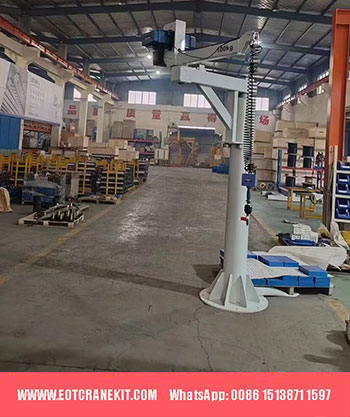
Articulating Jib Crane (Knuckle Boom Crane) 500KG -1 Ton :
Structure: Articulating jib cranes have a two-part jib arm with an elbow joint in the middle. This joint allows the jib arm to articulate or bend, offering both horizontal and vertical movement.
Movement: Articulating jib cranes can articulate or bend at the elbow joint, providing precise load positioning in tight spaces and complex layouts.
Features:
- Highly flexible movement with both horizontal and vertical reach.
- Typically designed for precise load positioning.
- Suitable for navigating around obstacles.
Benefits:
- Excellent maneuverability and precise load placement.
- Ideal for applications in confined spaces or around machinery.
- Provides versatility in handling loads with complex positioning requirements.
Applications/Use Cases:
- Handling materials in workshops or assembly lines with tight layouts.
- Positioning loads in congested areas or around obstacles.
- Precise placement of components during manufacturing or assembly.
The choice between these jib crane types depends on specific material handling needs, workspace constraints, and the level of flexibility required for load positioning. Each type offers distinct advantages for various applications.
Similarity and difference
Here are the main differences and similarities among fixed jib cranes, telescoping jib cranes, and articulating jib cranes:
Differences:
Jib Arm Movement:
- Fixed Jib Crane: The jib arm is stationary and does not have any movement features.
- Telescoping Jib Crane: It primarily extends and retracts horizontally.
- Articulating Jib Crane: It can articulate or bend at an elbow joint, offering both horizontal and vertical movement.
Flexibility:
- Fixed Jib Crane: Offers limited flexibility and is best suited for stationary applications with consistent load placement.
- Telescoping Jib Crane: Provides adjustable reach but primarily in a horizontal direction. It is adaptable for variable load distances.
- Articulating Jib Crane: Offers high flexibility with both horizontal and vertical reach, making it suitable for precise load positioning in tight spaces.
Complexity:
- Fixed Jib Crane: Simple in design with fewer moving parts.
- Telescoping Jib Crane: More complex due to its telescoping sections.
- Articulating Jib Crane: Can be relatively complex with articulation and multiple joints.
Cost:
- Fixed Jib Crane: Typically cost-effective due to its simplicity.
- Telescoping Jib Crane: May be more expensive due to the added complexity of telescoping sections.
- Articulating Jib Crane: Can be costlier due to its articulating design and precision.
Similarities:
- 1. Load Capacity: All three types of jib cranes can be designed to handle varying load capacities, from light-duty to heavy-duty applications.
- 2. Freestanding: Fixed, telescoping, and articulating jib cranes can all be freestanding, meaning they do not rely on existing structures for support.
- 3. Material Handling: They are all used for material handling tasks within industrial, manufacturing, and warehouse environments.
- 4. Hoisting Mechanisms: These jib cranes can be equipped with various hoisting mechanisms, such as electric chain hoists, wire rope hoists, or pneumatic hoists, depending on the specific application requirements.
- 5. Versatility: While their capabilities vary, all three types of jib cranes provide solutions for specific material handling needs and can be customized to fit various applications.
In summary, the main differences among fixed, telescoping, and articulating jib cranes lie in their jib arm movement capabilities and complexity. The choice between them depends on the specific material handling requirements and workspace constraints of a given application.
Based on Cantilever Design:
- Standard Cantilever Jib Crane: Standard cantilever jib cranes have a jib arm that extends horizontally from the support column.
- Full Cantilever Jib Crane: Full cantilever jib cranes have a jib arm that extends both horizontally and vertically, offering increased reach and flexibility.
Certainly, let's explore the structures, movements, features, benefits, applications, and use cases of standard cantilever jib cranes, drop cantilever jib cranes, I-beam jib cranes, and truss cantilever freestanding jib cranes:
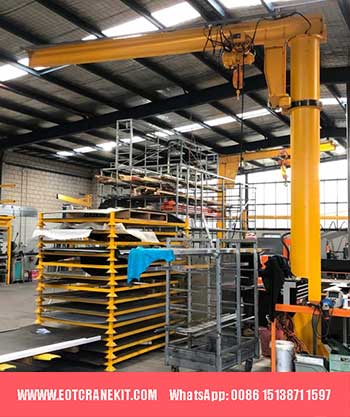
Standard Cantilever Jib Crane 5 Ton 10 Ton :
- Structure: A standard cantilever jib crane has a single horizontal jib arm extending from the support column. It forms an "L" shape with the column.
- Movement: The jib arm allows for horizontal movement, primarily offering an extension for reaching loads.
Features:
- Simple and space-efficient design.
- Well-suited for basic material handling needs.
- Cost-effective solution.
Benefits:
- Provides horizontal reach for loading/unloading, assembly, or positioning tasks.
- Saves floor space compared to other crane types.
Applications/Use Cases:
- Small workshops and manufacturing facilities.
- Loading and unloading goods from trucks.
- Material positioning along a production line.
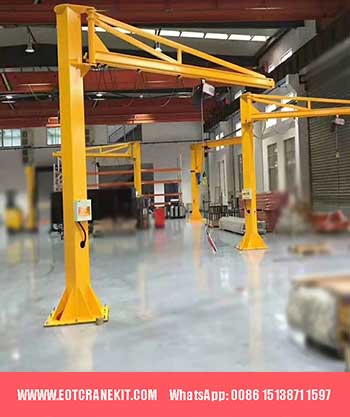
Drop Cantilever Jib Crane 0.25 kg -2 Ton :
- Structure: A drop cantilever jib crane has a jib arm with a vertical drop section at the end, extending below the horizontal jib.
- Movement: The design allows for precise vertical and horizontal load positioning, including lowering loads into tight spaces.
Features:
- Enables precise placement of loads in recessed or hard-to-reach areas.
- Versatile for various material handling scenarios.
Benefits:
- Ideal for tasks where loads need to be lowered into specific locations or tight clearances.
- Provides flexibility in navigating obstacles.
Applications/Use Cases:
- Workstations with limited access.
- Placing items on shelves or equipment in tight spaces.
- Handling materials in confined areas.

I-Beam Jib Crane 5Ton 10 Ton :
- Structure: An I-beam jib crane features an I-beam as the horizontal jib arm, offering enhanced strength and durability.
- Movement: Provides horizontal reach similar to standard cantilever jib cranes.
Features:
- Robust construction suitable for heavy-duty applications.
- Capable of lifting substantial loads.
Benefits:
- Ideal for handling heavy materials or equipment.
- Offers reliability and longevity.
Applications/Use Cases:
- Steel fabrication facilities.
- Shipyards.
- Anywhere heavy loads need to be positioned with precision.
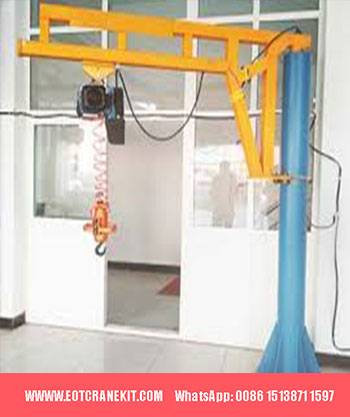
Truss Cantilever Freestanding Jib Crane 2 Ton :
- Structure: A truss cantilever jib crane incorporates a truss-like structure, which adds strength and stability to the jib arm.
- Movement: Offers horizontal reach like standard cantilever jib cranes, with added load-bearing capacity due to the truss design.
Features:
- High strength-to-weight ratio.
- Suitable for heavy-duty applications.
Benefits:
- Handles heavy loads with ease.
- Resists deflection and maintains stability.
Applications/Use Cases:
- Construction sites.
- Ports and shipping facilities.
- Handling large machinery or equipment.
Each type of cantilever jib crane serves specific material handling needs and is chosen based on factors such as load capacity, reach, and workspace constraints. The versatility and specialized features of these cranes make them valuable tools in various industries and applications.
Similarities and differences
Here are the main similarities and differences among standard cantilever jib cranes, drop cantilever jib cranes, I-beam jib cranes, and truss cantilever freestanding jib cranes:
Similarities:
- 1. Freestanding Structure: All four types of jib cranes are freestanding, meaning they do not rely on existing structures for support and have their own self-supporting bases.
- 2. Material Handling: They are designed for material handling applications, including lifting, positioning, and transporting loads within industrial settings.
- 3. Horizontal Reach: Each type provides horizontal reach, allowing loads to be moved horizontally across a workspace.
- 4. Customization: These jib cranes can be customized to match specific load capacities, reach requirements, and workspace constraints.
Differences:
Design and Structure:
- Standard Cantilever Jib Crane: Has a single horizontal jib arm extending from the support column, forming an "L" shape.
- Drop Cantilever Jib Crane: Features a vertical drop section at the end of the jib arm, allowing for precise vertical and horizontal load positioning.
- I-Beam Jib Crane: Utilizes an I-beam as the horizontal jib arm, providing added strength and durability.
- Truss Cantilever Freestanding Jib Crane: Incorporates a truss-like structure for enhanced load-bearing capacity.
Movement and Positioning:
- Standard Cantilever Jib Crane: Offers horizontal reach for basic material handling tasks.
- Drop Cantilever Jib Crane: Allows precise lowering and positioning of loads in tight spaces.
- I-Beam Jib Crane: Provides horizontal reach and is suitable for heavy-duty lifting.
- Truss Cantilever Freestanding Jib Crane: Offers horizontal reach with added strength for heavy loads.
Use Cases and Applications:
- Standard Cantilever Jib Crane: Suited for basic material handling in small workshops and manufacturing facilities.
- Drop Cantilever Jib Crane: Ideal for tasks requiring precise vertical and horizontal load placement in confined areas.
- I-Beam Jib Crane: Used in heavy-duty applications, such as steel fabrication and shipyards.
- Truss Cantilever Freestanding Jib Crane: Designed for handling large machinery or equipment in demanding industrial environments.
Load Capacity:
- Standard Cantilever Jib Crane: Suitable for light to moderate loads.
- Drop Cantilever Jib Crane: Varies based on design but generally used for moderate loads.
- I-Beam Jib Crane: Designed for heavy loads.
- Truss Cantilever Freestanding Jib Crane: Suited for heavy-duty lifting applications.
In summary, while these types of jib cranes share some similarities, such as their freestanding nature and ability to provide horizontal reach, their differences lie in their specific designs, movement capabilities, load capacities, and ideal use cases. The choice of which type to use depends on the unique material handling requirements of a given application.
Based on Hoisting System:
- Electric Chain Hoist Jib Crane: These cranes are equipped with an electric chain hoist for lifting and lowering loads.
- Wire Rope Hoist Jib Crane: Utilizes a wire rope hoist for lifting and lowering heavy loads.
- Pneumatic (Air) Hoist Jib Crane: Powered by compressed air, offering a clean and efficient lifting solution.
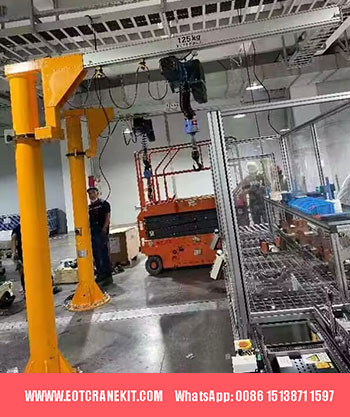
Electric Chain Hoist Jib Crane 5 Ton 10 Ton :
- Structure: Electric Chain Hoist Jib Cranes consist of a freestanding jib arm with an attached electric chain hoist that is used for lifting and lowering loads.
- Movement: The crane provides horizontal movement, allowing the load to be moved within the crane's coverage area.
Features:
- Electric chain hoists are compact and offer precise load control.
- Remote control options for safe and convenient operation.
- Chain hoists are available in various load capacities.
Benefits:
- Reliable and precise load positioning.
- Suitable for a wide range of load capacities and material handling tasks.
- Can be used for repetitive lifting and lowering operations.
Applications/Use Cases:
- Manufacturing and assembly lines.
- Loading and unloading materials from trucks or containers.
- Material positioning in workshops and warehouses.
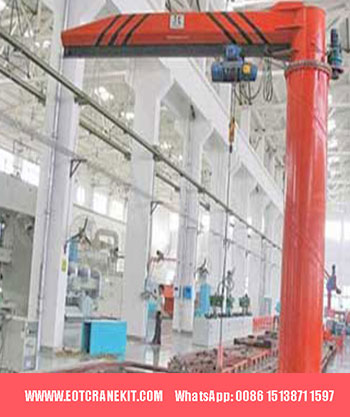
Wire Rope Hoist Jib Crane 5 Ton 10 Ton 16 Ton :
- Structure: Wire Rope Hoist Jib Cranes feature a freestanding jib arm with an attached wire rope hoist that is used for lifting and lowering heavy loads.
- Movement: Similar to electric chain hoist jib cranes, they provide horizontal movement for load positioning.
Features:
- Wire rope hoists are capable of handling heavy loads with high lifting capacities.
- Offers reliable and precise load control.
- Various hoist and trolley configurations available.
Benefits:
- Ideal for heavy-duty lifting and material handling applications.
- Suitable for tasks requiring high load capacity and long lifting heights.
- Can be customized for specific operational needs.
Applications/Use Cases:
- Construction sites.
- Foundries and metalworking facilities.
- Shipyards and docks for loading and unloading cargo.
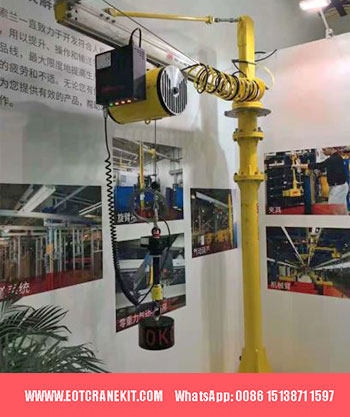
Pneumatic (Air) Hoist Jib Crane 500KG :
- Structure: Pneumatic Hoist Jib Cranes consist of a jib arm equipped with a pneumatic (air-powered) hoist for lifting and lowering loads.
- Movement: They provide horizontal movement for load positioning, similar to electric and wire rope hoist jib cranes.
Features:
- Pneumatic hoists use compressed air for lifting and are known for their clean and efficient operation.
- Remote control options for ease of use.
- Suitable for applications where electricity is not ideal or in hazardous environments.
Benefits:
- Provides a clean and environmentally friendly lifting solution.
- Suitable for areas where the use of electricity is restricted or unsafe.
- Offers a reliable and controlled lifting process.
Applications/Use Cases:
- Hazardous environments such as chemical plants or areas with explosive atmospheres.
- Workspaces where clean air quality is critical, like clean rooms or food processing facilities.
- Material handling tasks in locations without electrical power sources.
Each type of hoist jib crane offers unique advantages and is selected based on load capacity, operational requirements, environmental considerations, and safety concerns in various industrial and manufacturing settings.
Similarity and Difference
Here are the main similarities and differences among Electric Chain Hoist Jib Cranes, Wire Rope Hoist Jib Cranes, and Pneumatic (Air) Hoist Jib Cranes:
Similarities:
- 1. Material Handling: All three types of hoist jib cranes are designed for material handling tasks, including lifting, lowering, and positioning loads within industrial settings.
- 2. Horizontal Movement: They provide horizontal movement capabilities, allowing loads to be moved horizontally across the crane's coverage area.
- 3. Load Control: These cranes offer precise load control, allowing for accurate positioning of loads during lifting and lowering operations.
- 4. Remote Control: Remote control options are available for safe and convenient crane operation, enhancing operator flexibility and safety.
Differences:
Hoist Type:
- Electric Chain Hoist Jib Crane: Equipped with an electric chain hoist for lifting and lowering loads. Electric chain hoists are known for their compact size and precise load control.
- Wire Rope Hoist Jib Crane: Utilizes a wire rope hoist for handling heavy loads, making them suitable for high-capacity lifting tasks. Wire rope hoists are often used in heavy-duty applications.
- Pneumatic (Air) Hoist Jib Crane: Powered by compressed air, offering a clean and efficient lifting solution. Pneumatic hoists are chosen for their suitability in environments where electricity is restricted or unsafe, or where clean air quality is essential.
Load Capacity:
- Electric Chain Hoist Jib Crane: Suitable for a wide range of load capacities, including light to moderate loads.
- Wire Rope Hoist Jib Crane: Designed for heavy-duty lifting, making them ideal for handling heavy and substantial loads.
- Pneumatic (Air) Hoist Jib Crane: Load capacity varies but is typically used for tasks within the range of light to moderate loads.
Operational Environments:
- Electric Chain Hoist Jib Crane: Versatile and suitable for various industrial environments where electricity is readily available and safe.
- Wire Rope Hoist Jib Crane: Commonly used in demanding industrial settings, such as construction sites, foundries, and shipyards.
- Pneumatic (Air) Hoist Jib Crane: Chosen for environments where the use of electricity may be restricted, unsafe, or where clean air quality is a concern, such as clean rooms and hazardous locations.
Customization: Each type can be customized to match specific load capacities, reach requirements, and operational needs, allowing for flexibility in their applications.
In summary, while these hoist jib cranes share common features like horizontal movement and load control, their primary differences lie in the type of hoist used, load capacity, suitability for specific environments, and their intended applications. The choice among them depends on the specific material handling requirements, load capacities, and environmental considerations of a given industrial or manufacturing setting.
Based on Mobility of Free Standing Jib Crane

Fixed Base Jib Crane 5 Ton 10 Ton :
- Structure: A Fixed Base Jib Crane is stationary and securely anchored to a fixed base or support structure. It consists of a vertical mast, a horizontal jib arm, and a hoisting mechanism.
- Movement: These cranes do not have mobility features, meaning they cannot move from their fixed position. They provide a fixed range of motion.
Features:
- Stable and sturdy construction.
- Suitable for permanent material handling needs.
- Available in various load capacities and jib arm lengths.
Benefits:
- Offers a reliable and fixed point for lifting and positioning loads within a specific area.
- Minimal maintenance requirements due to their simple design.
- Well-suited for repetitive material handling tasks.
Applications/Use Cases:
- Loading and unloading materials in designated workstations.
- Material handling in manufacturing, assembly, and maintenance facilities.
- Use in areas where a stationary lifting solution is required.
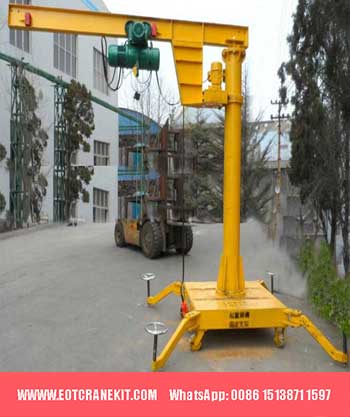
Portable Jib Crane 1Ton 2 Ton :
- Structure: Portable Jib Cranes are designed for easy disassembly and transportation. They typically consist of a vertical mast, a horizontal jib arm, and a wheeled base for mobility.
- Movement: These cranes are portable and can be easily moved to different locations. They provide mobility within their workspace.
Features:
- Wheeled base or caster wheels for mobility.
- Quick assembly and disassembly without the need for tools.
- Available in various load capacities and jib arm lengths.
Benefits:
- Flexibility to move the crane to different work areas or job sites as needed.
- Ideal for remote or temporary projects where a fixed crane is not practical.
- Versatile and adaptable to changing material handling requirements.
Applications/Use Cases:
- Construction sites for lifting and positioning materials.
- Loading and unloading cargo from trucks and containers at various locations.
- Maintenance tasks in different areas of a facility.

Foundation Jib Crane 5 Ton 10 Ton 16 Ton :
A foundation jib crane is a type of jib crane that is installed with a dedicated foundation or base. This foundation provides stability and support for the crane. There are two main categories of foundation jib cranes:
Foundationed Jib Crane with a Dedicated Foundation:
- Structure: This type of jib crane is securely anchored to a concrete foundation that is specifically constructed to support the crane's load-bearing requirements.
- Benefits: Offers excellent stability and load-bearing capacity, making it suitable for heavy-duty lifting and precise material handling tasks.
- Applications: Commonly used in manufacturing facilities, warehouses, and industrial environments where consistent, precise, and heavy lifting is required.
Foundationless Jib Crane with a Bolted Base:
- Structure: These jib cranes have a bolted base that is anchored to the existing concrete floor without the need for a dedicated foundation.
- Benefits: Provides a stable and secure lifting solution without the cost and time associated with foundation construction.
- Applications: Suitable for applications where mobility within the facility is needed, such as changing workstations or adapting to evolving material handling needs.
Foundation Types for Foundationed Jib Cranes:
- 1. Concrete Foundation: The most common type of foundation for jib cranes is a concrete pad or slab. It provides a stable and durable base for the crane, capable of withstanding heavy loads and ensuring precise positioning.
- 2. Reinforced Concrete Foundation: In cases where the crane will handle extremely heavy loads or operate in challenging environments, a reinforced concrete foundation with added steel reinforcement may be used to enhance strength and stability.
- 3. Pier Foundation: For outdoor applications or locations with soil conditions that require additional support, a pier foundation with deep concrete footings may be used to anchor the crane securely.
- 4. Specialized Foundations: Some specialized applications may require unique foundation designs, such as elevated platforms or specialized anchor points, to accommodate specific material handling needs.
Similarities and Differences in Foundation Types:
Similarities:
- All foundation types are designed to provide stability and support for the jib crane.
- They ensure the safe operation of the crane and prevent tipping or instability during lifting tasks.
Differences:
- The choice of foundation type depends on factors like load capacity, soil conditions, and the crane's intended application.
- While concrete foundations are the most common, specialized foundations may be needed for unique requirements or challenging environments.
- Foundationless jib cranes, with bolted bases, offer mobility and are suitable for areas where a dedicated foundation may not be practical.
In summary, foundation jib cranes are categorized based on whether they use dedicated foundations or bolted bases, with various foundation types available to suit different applications and load requirements. The selection of the appropriate foundation type is crucial to ensure the crane's stability, safety, and efficiency in material handling tasks. Check more on foundation jib crane and foundationless jib crane.

Foundationless Freestanding Jib Crane (Bolted Base Jib Crane) 500KG:
Structure: Foundationless jib cranes are designed with a bolted base that is securely anchored to the existing concrete floor of a facility. They consist of a vertical mast, a horizontal jib arm, and the bolted base.
Benefits:
- Cost-Efficiency: One of the primary advantages is cost savings, as they eliminate the need for dedicated foundation construction. This can be especially beneficial when considering installation expenses.
- Quick Installation: Foundationless jib cranes can be installed more quickly compared to cranes that require foundation construction. This minimizes downtime during setup.
- Mobility: They provide mobility within the facility. Since they are not permanently anchored to the ground, they can be relocated as needed to adapt to changing material handling requirements.
- Versatility: These cranes are versatile and can serve multiple workstations or areas within a facility. Their mobility allows them to be used where they are needed most.
- Load Capacity: Foundationless jib cranes are available in various load capacities, making them suitable for a wide range of material handling tasks.
Applications/Use Cases:
- Changing Workstations: Foundationless jib cranes are ideal for applications where workstations need to be frequently relocated or adapted to different tasks.
- Manufacturing and Assembly: They are commonly used in manufacturing and assembly lines to assist with loading and unloading, part positioning, and assembly tasks.
- Warehouses and Distribution Centers: These cranes can help with cargo handling and palletizing in warehouses where flexibility is essential.
- Maintenance Areas: Foundationless jib cranes are useful in maintenance facilities for hoisting equipment and performing maintenance tasks.
- Versatile Material Handling: Their mobility and adaptability make them valuable for various material handling tasks, including handling raw materials, components, and finished products.
Note: While foundationless jib cranes offer mobility and cost-efficiency, they may have load limitations compared to jib cranes with dedicated foundations. The choice between foundationless and foundationed jib cranes depends on factors such as load capacity, workspace layout, installation time, and the need for mobility within the facility.
Foundationless freestanding jib cranes are a valuable addition to facilities where adaptability, quick installation, and cost savings are priorities, providing a versatile solution for various material handling tasks.
Each type of jib crane offers specific advantages based on mobility, range of motion, and load capacity requirements. The choice among them depends on the material handling needs, workspace layout, and flexibility needed for a particular application.
Similarities and Differences
Here are the main similarities and differences among Fixed Base Jib Cranes, Portable Jib Cranes, and Rotating Base Jib Cranes:
Similarities:
- 1. Material Handling: All three types of jib cranes are designed for material handling tasks, including lifting, lowering, and positioning loads within industrial settings.
- 2. Jib Arm: They share the common design elements of a vertical mast and a horizontal jib arm for load handling.
- 3. Customization: These cranes can be customized to match specific load capacities, reach requirements, and operational needs, offering flexibility in their applications.
Differences:
Mobility:
- Fixed Base Jib Crane: Stationary and anchored to a fixed base or support structure, offering no mobility features.
- Portable Jib Crane: Designed for easy disassembly and transportation, featuring a wheeled base or caster wheels for mobility.
- Rotating Base Jib Crane: Equipped with a rotating base that allows the entire crane to rotate horizontally, providing a greater range of motion.
Range of Motion:
- Fixed Base Jib Crane: Provides a fixed range of motion and cannot move from its anchored position.
- Portable Jib Crane: Offers mobility within its workspace but still has limitations in terms of the range of motion compared to rotating base cranes.
- Rotating Base Jib Crane: Provides a 360-degree horizontal range of motion, allowing the crane to reach various positions within its workspace.
Applications:
- Fixed Base Jib Crane: Suited for permanent material handling needs in designated workstations or areas.
- Portable Jib Crane: Ideal for remote or temporary projects where mobility is required, and a fixed crane is not practical.
- Rotating Base Jib Crane: Provides a broader coverage area and is suitable for applications requiring precise load positioning in multiple directions.
Assembly and Disassembly:
- Fixed Base Jib Crane: No assembly or disassembly required once installed.
- Portable Jib Crane: Designed for quick assembly and disassembly without the need for tools, facilitating transportation.
- Rotating Base Jib Crane: Typically requires assembly but can be locked into a fixed position when needed.
In summary, these jib crane types differ primarily in terms of mobility, range of motion, and suitability for specific applications. Fixed base cranes are stationary, portable cranes offer mobility within their workspace, and rotating base cranes provide a wider range of motion for material handling tasks. The choice among them depends on the material handling requirements, workspace layout, and flexibility needed for a particular application.
Related Products

Latest project
150 Ton Overhead Crane Installation Feedback – Paraguay Case
QDX 150 ton overhead crane in action in Paraguay. Installation photos, video, and client feedback show performance, safety, and heavy-lifting efficiency.
Free consultation to Confirm Parameters & Specifications and Get
Latest Crane Price & Crane Rate.
- Types of overhead cranes : _______?
- Optional: Overhead travelling crane, goliath gantry crane,Slewing jib crane, Single girder or double girder crane,small portable crane or kbk crane, etc.
- Capacity of overhead crane: _______?
- Optional: 0.25ton, 0.5 ton, 1 ton, 2 ton, 3ton, 5 ton, 10 ton,15ton, 20ton, 25 ton, 30ton,35ton, up to 550ton, etc.
- Crane span & lifting height : _______?
- Crane travelling length : _____?
- Control of overhead crane:_______?
- Optional: pendant/ remote/cabin control
- Voltage supply of overhead crane:_____?
- Eg,: 380V50/60HZ,3Phase or others,etc.
- Application/usage of crane:_______?
- Eg,: Steel mill, ,injection mold, cement,stone, concrete,granite, general manufacturing, etc.
Just leave a message via the contact form and our hoist and crane engineer will contact you with in 24working hours.
Get In Touch
